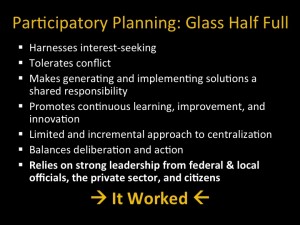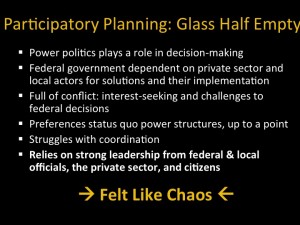Planning the Home Front argues that the U.S. federal government used a participatory planning approach to mobilize the American home front.
Over the last six months, I’ve had the privilege of presenting this argument to audiences of urban planners, both in Dublin, Ireland and in Washington, DC. I’ve enjoyed the exchanges with other planners and with people who spend a lot of time thinking about planning. What struck me as I researched the American home front mobilization is how different World War II era “participation” was from contemporary ideas of “public participation.” This came out in many of my discussions with others too.
At the Fifth Congress of the Association of European Schools of Planning/ Association of Collegiate Schools of Planning held in Dublin, Ireland, July 15-19, 2013, I presented examples of participatory planning as it played out in terms of housing for the workers at the Willow Run Bomber Plant.
Paper Excerpt:
Instead of comprehensive planning, Planning the Home Front argues that the federal government adopted a participatory planning approach to mobilizing the American home front. Total war demanded significant top-down direction, of course, but it is the presence of an equally significant role for the “bottom up” that makes this an interesting and important planning model. As the top-down engaged the bottom-up, national objectives (win the war) joined local objectives for building communities, and interest group politics were harnessed to a national project (total war). For Willow Run, the federal government dictated the goal (produce bombers), but federal policy left many of “the means” to the local level–and often to individuals. Indeed, many of the means implemented at Willow Run would qualify for what Leonie Sandercock calls planning as “community building” or planning as “self-help, community solidarity, and community organizing for social and economic development” (Sandercock 1998, pp. 9-10).
A PDF of the conference paper, Lessons from the Housing Crisis on the American Home Front during World War II, is available here: Dublin Paper Draft.
In October, I presented an extended version of the participatory planning argument as part of the American Planning Association’s Tuesdays at APA speaker series in Washington, DC. The APA website includes links to the slides and audio recording of the presentation and discussion.
In both presentations, I closed by presenting summaries of the pros and cons of the American World War II planning model:
 And then turned to discussion with three starter questions for the audience:
And then turned to discussion with three starter questions for the audience:
- How is today’s public participation in planning different from the World War II model?
- Do you see this type of planning at work today? Where?
- Do you think the World War II model has advantages? Worth emulating?
I welcome your comments and ideas.

